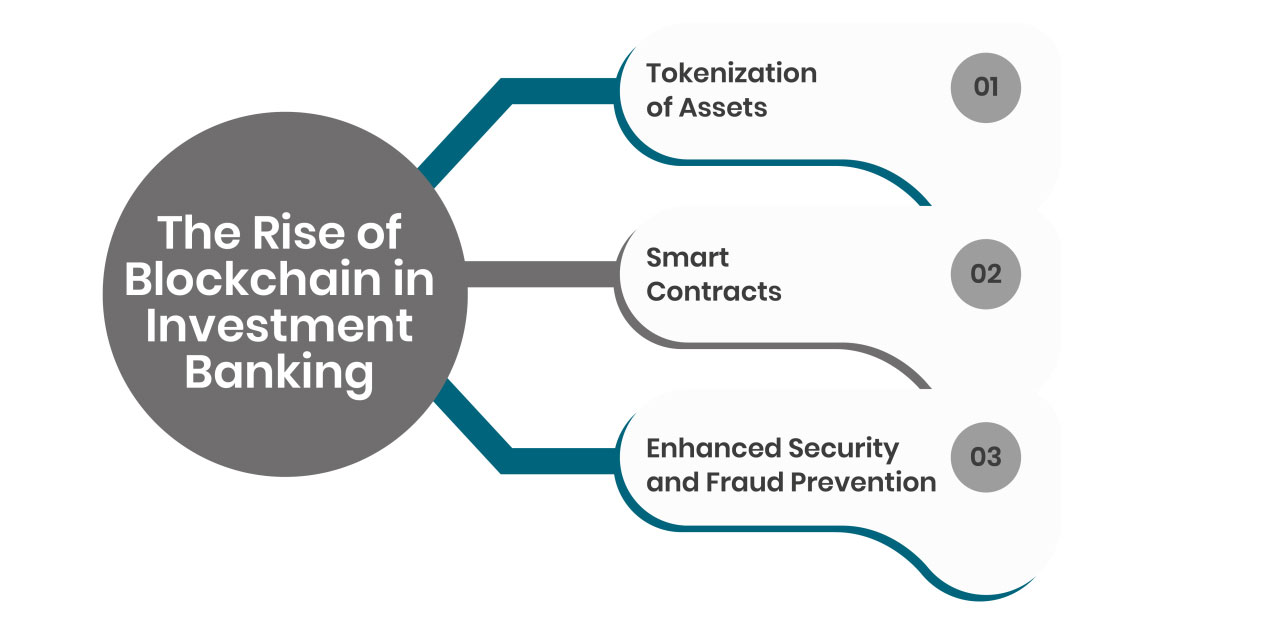Introduction
Blockchain and direct listing technologies are replacing conventional methods used by Investment Banking in today’s dynamic environment. The adoption of these new technologies sees the increasing importance of AI in investment banking, automating smarter decisions and thereby improving day-to-day operations. This article explores how these advanced technologies are changing the industry with a specialization in investment banking integrating Generative AI to enhance operations.
The Rise of Blockchain in Investment Banking
Blockchain technology has completely disrupted the investment banking industry with a new level of transparency, security, and efficiency in its infrastructure. Blockchain decentralized transaction verification, eliminating the need for intermediaries which decreases the costs and increases processing times. This foundational change has made blockchain indispensable in several core areas of investment banking:

-
Tokenization of Assets: The tokenization of assets, from shares to bonds to other securities, is made possible via blockchain. This creates a linear pipeline for asset trading, increases the liquidity by generating multipliers for tokens of ownership, and enables fractional ownership breaking the barriers for investing of a wider range of investors.
-
Smart Contracts: Blockchain smart contracts eliminate manual intervention and thereby removing human error. These smart contracts can reduce investment banking processes through clearing, settlement, and even complicated derivative transactions, increasing operational efficiency.
-
Enhanced Security and Fraud Prevention: Blockchains are tamper-resistant ledgers, which means they can be both encrypted and decentralized, reducing fraud and securing data. This is especially important for investment banks, which process large, high-stakes transactions, by affording protection of their clients’ sensitive information and by strengthening compliance.
Blockchain technology is advancing, and while its applications in investment banking is set to grow, it should also spur further innovation and operational improvements across the sector.
Direct Listing Technologies: A New Avenue for Public Offerings
Direct listing is a new pathway to becoming publicly traded that is an alternative to Initial Public Offerings (IPOs). A direct listing is when a company skips the regular underwriting process and rather, shareholders are allowed to trade their existing shares on the stock exchange. This method practically eliminates the cost of going public by removing the necessity of using underwriting by investment bank intermediaries.
-
Cost Efficiency: The biggest advantage of a direct listing is that it eliminates underwriting fees and the hassle of holding a roadshow, which makes it cheaper for these companies, particularly high-growth tech firms.
-
Transparency: It enables investors to gain exposure to real-time pricing because there is no pre-set price range. The demand will decide what the price should be.
-
Market Access: Direct listings allow employees, insiders, and early investors to sell more easily, and this contributes to increased liquidity.
Direct listings are generally a better fit for well-capitalized and previously well-known companies. However, they are changing the traditional IPO model by allowing companies to go public without as much risk and at a much lower cost.
How Blockchain and Direct Listings Together are Shaping Future Markets?
Blockchain and direct listing technologies are changing the way markets work to provide more transparency and efficiency for both the investor and the company. Incorporating the decentralization of blockchain with the direct listings' innovative process, future markets are transitioning toward enhanced accessibility and a lesser reliance on intermediaries.
-
Decentralized Marketplaces and Peer-to-Peer Trading: Being a decentralized technology, blockchain allows us to create peer-to-peer marketplaces where people can trade the assets themselves without intermediaries. This approach improves transparency and delivers power to the hands of investors by bringing down the usual expenses linked with brokers and middlemen.
-
Real-Time Settlement and Transaction Efficiency: Blockchain is a key tool in the real-time settlement of trades, as it is favorable for direct listings aimed at minimizing excessive time delays. The blockchain-based direct listing will come with faster, more accurate registers of trades and asset transfers, as all trades and asset transfers are entered into the immutable ledger.
-
Increased Accessibility and Investor Reach: Tokenizing shares brings more people to direct listings through blockchain, allowing for smaller, fractional investments. This inclusion contributes to market democratization by appealing to a wider pool of investors.
-
Cost Reduction in Capital Raising: Cost efficiency is achieved by both blockchain and direct listing technologies. Data verification on blockchain helps bypass traditional underwriting fees, presenting companies undertaking direct listings as a cheap and effective way to raise capital, especially for tech-driven firms.
Integrating blockchain with direct listings has shifted markets towards a combination of a more streamlined marketplace, one that is more accessible to modern, tech-savvy investors. This is the future look of investment banking which will deliver business with transparency, efficiency, and accessibility.
Role of AI in Investment Banking: Amplifying Blockchain and Direct Listing Efforts
AI in investment banking is upgrading blockchain and direct listing technologies to improve their capabilities, enabling investment banks to perform their tasks more efficiently and securely. Here’s how AI is being integrated into these innovative technologies:
-
AI-Enhanced Blockchain Solutions: Investment banks are now using AI-driven analytics on blockchain data to help them detect patterns and anomalies for fraud prevention. Machine learning algorithms analyze Blockchain transactions in real time, identifying potential issues for review before they become critical. Predictive AI also lets you predict how trends work in DeFi, which is also useful in developing investing strategies.
-
Fraud Detection and Compliance: In the blockchain, AI can automate processes like KYC (Know Your Customer) and AML (Anti Money Laundering) which will decrease time and operational risk. Algorithms are to identify unusual transactions and play the role of an extra layer of security.
-
AI’s Role in Direct Listings: AI optimizes listing strategies for direct listings by analyzing market data and identifying high-potential investor groups. Machine learning models allow the company to enter the market under favorable conditions with the prediction of market sentiment and timing.
-
Generative AI for Document Processing: Generative AI accelerates company operations with automatic document-heavy tasks like client onboarding and regulatory compliance reducing back-office tasks. It enables investment banking firms to allocate limited resources to more value-added work while maintaining accuracy and security.
Generative AI in Investment Banking: Innovating Client Interactions and Analysis
Investment banking is evolving with Generative AI— offering extraordinary effectiveness and personalization. Using advanced AI models banks are capable of offering more personalized and reactive client interactions, maximizing client decision-making, and enriching customer engagement.
-
Customer Service and Support: Banks can use generative AI power to automate and personalize responses and weave a more interactive client experience. AI-powered chatbots and virtual assistants can answer inquiries in a fast time, thus providing 24*7 support that can take human resources off doing more complex cases. AI solutions learn from each interaction and will change and become more accurate and more relevant over time to provide a better experience for the client.
-
Data Generation for Strategic Decisions: Generative AI can help banks in creating massive datasets, which they can use to derive insights for investment strategy. Structured and unstructured data can be analyzed by AI models to help trade-making decisions or detect emerging trends. This capability gives us the ability to take proactive, precise data-based strategies faster.
-
Enhancing Blockchain Insights: Generative AI can also be used to create action from that blockchain data. An example might be using blockchain's transparency alongside AI's analytical power to offer banks an unprecedented capability of predicting market movement and evaluating risk more accurately, enabling smarter investment decisions and a broader, more intelligent client advisory process.
The Future of Blockchain, Direct Listings, and AI in Investment Banking
Blockchain, direct listings, and AI in investment banking are changing the face of investment banking. As the technologies mature, it is a given that they will become more streamlined and client-centric.
Key emerging trends include:
-
Enhanced Interoperability: Blockchain technology may facilitate a more seamless interplay between the banks, clients, and markets, which will consequently promote better coordination.
-
Personalized Strategies: Investment banking is expected to capitalize on generative AI capabilities to deliver deep data-driven insights, crafting unique strategies tailored to clients.
-
Increased Accessibility for Investors: AI-enabled analytics will help open more doors for a diverse set of investors to gain access to public offerings through direct listing.
These technologies, taken together, will spur investment banks towards a future where security, transparency, and efficiency are inalienable, leading to an operational and strategic landscape in the industry like never before.
Conclusion
Blockchain, direct listing technologies, and AI in investment banking are bringing an entirely new level to our financial market’s future. These innovations strengthen security, transparency, and operational efficiency, leaving investment banks with the opportunity to maintain their position in a fast-changing world. Firms can then leverage these technologies to propel progress, access new opportunities, and provide clients with more streamlined, data-driven services, all of which contribute to long-term growth and competitiveness.

